Peace and Nonviolence
WHEN CHIEF MASTER Sergeant Harry Marsters returned in 2008 from his time in Iraq, he knew something wasn’t right. At 54, the 32-year veteran of the Air Force—with 27 years full time in the military and the remainder as a reservist with the Air National Guard—felt that as one of the “older folks” he knew what to expect upon return from his assignment with the communications squad at the Kirkuk Regional Air Base in northern Iraq.
Marsters’ squadron trained Iraqi forces in the operation and maintenance of aerial surveillance equipment on the base, which housed 1,000 Air Force and 2,500 Army troops. As first sergeant he acted as a liaison to the Air Force troops and ensured the well-being of those stationed there. It was a job he relished, pouring care into building connections with the airmen and women, spending time with the chaplains, and coordinating recreation and morale-building activities.
Though Air Force personnel never left the base, they were subjected to the ever-present threat of randomly timed mortar rounds launched by insurgents. They also took part in nighttime “patriot details” in which Air Force personnel and soldiers lined the base’s runway as the bodies of fallen soldiers were loaded onto planes for transport back to the United States. But Marsters says he was most upset by what he felt was harsh treatment of the Iraqi nationals who came to work on the base.
“They were treated like criminals,” he says of the extensive searches and intimidation Iraqis received when going through base security. “Everyone in Iraq is not evil, bad, and nasty. It’s a very small group of people who are raising hell and trying to hurt the country. The average person is just trying to make some money and take care of his or her family.”

Secretary of State John Kerry brought his argument for a two-state Israeli-Palestinian peace to the annual AIPAC conference this week, and whatever else we might know, we know this: Many evangelical Christians didn’t like it.
Or at least that’s what we’re told by some Christian leaders and their political allies. Supporting Israel’s government by opposing compromise with the Palestinians is a permanent plank in American evangelical political thought. “God told Abraham that he would bless those who bless him and the nation of Israel,” the thinking goes, “and curse those that curse Israel.”
But could it be that the truth is more complicated?
What if the loudest evangelical voices don’t represent the complexity of our community? I raise these questions as an evangelical who is fully committed to supporting the struggle for security, dignity, and freedom for Israelis and Palestinians. And I’m not alone.
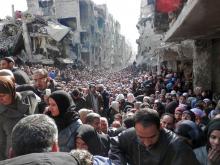
Last week amid the closing of the Olympics, the national debt, and the latest pop culture ‘news,’ this photo was published that encapsulates the volume of pain and suffering that is happening in Syria. For years, the conflict in Syria has gone through its ebbs and flows; it has been in and out of the media’s attention. Even though thousands of people have been displaced and families have been forced to eat animal feed, this is not worthy for American front-page news. Sadly, travesties around the world, or even in our backyard, are categorized as “out of sight, out of mind.” Too often we are consumed by other things than those outside of our limited purview.
When I saw the photo of the suffering of the Syrians, I was shocked; I was shocked that so many people were in line to get food, shocked that despite their best efforts there is not enough food to go around. I felt sad for the people who, by no fault of their own, live in a country that is being ravaged by war, violence, greed, and power struggles. I felt embarrassed for all of the times I whined and complained about my own “problems.” All of them collectively wouldn’t even begin to compare to what people are facing in Syria at this very moment. I wanted to find a way to do something, to raise my voice for them ... anything.

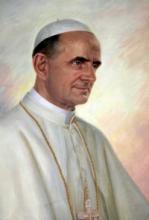
It’s almost a year since Pope Francis was chosen as Benedict XVI’s successor. The Argentinian-born pontiff has quickly achieved global fame for his numerous statements indicating that significant changes may be coming to the Roman Catholic Church.
One possible change emerged last month when London’s Sunday Times reported that Francis wants to make public the Vatican’s archives of Pius XII’s pontificate. Eugenio Pacelli became pope in 1939 and served as pontiff during the period of World War II and the Holocaust until his death in 1958.
According to the British newspaper, Francis wants to release the Pius XII papers for study before determining whether to consider his controversial predecessor for sainthood. Francis has already “fast-tracked” the path to sainthood for John XXIII and John Paul II, but not Pius XII.
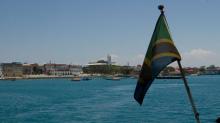
After months of calm in Zanzibar, two homemade bombs exploded Monday near St. Monica Anglican Cathedral and the Mercury restaurant, a popular hangout for tourists visiting the Indian Ocean archipelago.
No one was hurt, but one day earlier, four people were injured in another explosion, targeting an Assemblies of God church.
The attacks are blamed on the secessionist Uamsho, a religious group pressing for the full autonomy of the archipelago. Uamsho, which means “awakening” in Swahili, is also known as the Association for Islamic Mobilization and Propagation.

Pope Francis on Tuesday lashed out at public indifference to the many wars raging around the globe, with especially harsh words for arms makers who he said profit from the violence and suffering.
“Think of the starving children in the refugee camps. Just think of them: this is fruit of war!” Francis said at the daily Mass he celebrates in the chapel of the Vatican guesthouse where he lives.
“And if you want,” he continued, “think of the great dining halls, of the parties thrown by the bosses of the weapons industry that makes the arms that wind up [in those camps]. A sick child, starving, in a refugee camp — and the great parties, the fine life for those who manufacture weapons.”
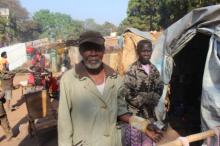
Churches in Central African Republic are caring for thousands of Muslims who have been trapped in a cycle of revenge attacks, perpetrated by a pro-Christian militia.
Since December, Anti-Balaka militias have been emptying Muslim quarters and avenging earlier attacks by the Seleka, an Islamist militia. The Seleka rampaged through the country in early 2013, terrorizing Christians and ransacking churches, hospitals, and shops.
Now that the Muslim president Michel Djotodia has stepped down, Seleka is being forced to withdraw from its strongholds, as the center of power shifts, amid a mass exodus and displacement of Muslims.

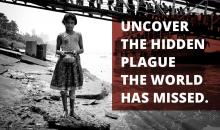
When we think about the poor of the world our thoughts often drift toward starvation, unsafe water, malaria, and lack of medical attention. These thoughts will likely move us to taking action in a variety of ways. We give farming skills and equipment, we drill wells, we provide mosquito netting, and doctors volunteer their time to help treat the poor of the world.
All of these things can be helpful and beneficial but there is a deeper, much darker, problem below the surface of poverty. The problem is violence. Gary Haugen, the founder of International Justice Mission, recently released a new book titled The Locust Effect, which documents the plight of the poor in developing countries.
What benefit is it to provide schooling for girls that refuse to attend because many of them get raped when they attend? How can a micro-loan help a father provide for his family when he gets thrown into prison for a crime he didn't commit and can't afford to bribe the law enforcement? How is a mother supposed to care for her children when her home is taken away from her by her husband's family once he dies?

Two weeks ago in a room in Kabul, Afghanistan, I joined several dozen people — working seamstresses, some college students, socially engaged teenagers, and a few visiting internationals like myself — to discuss world hunger. Our emphasis was not exclusively their own country’s worsening hunger problems. Rather, tmhe Afghan Peace Volunteers, in whose home we were meeting, draw strength from looking beyond their own very real struggles.
With us was Hakim, a medical doctor who spent six years working as a public health specialist in the central highlands of Afghanistan and, prior to that, among refugees in Quetta, Pakistan. He helped us understand conditions that lead to food shortages and taught us about diseases, such as kwashiorkor and marasmus, which are caused by insufficient protein or general malnutrition.
We looked at U.N. figures about hunger in Afghanistan, which show malnutrition rates rising by 50 percent or more compared with 2012. The malnutrition ward at Helmand Province’s Bost Hospital has been admitting 200 children a month for severe, acute malnutrition — four times more than in January 2012.
A recent New York Times article about the worsening hunger crisis described an encounter with a mother and child in an Afghan hospital: “In another bed is Fatima, less than a year old, who is so severely malnourished that her heart is failing, and the doctors expect that she will soon die unless her father is able to find money to take her to Kabul for surgery. The girl’s face bears a perpetual look of utter terror, and she rarely stops crying.”
Photos of Fatima and other children in the ward accompanied the article. In our room in Kabul, Hakim projected the photos on the wall. They were painful to see and so were the nods of comprehension from Afghans all too familiar with the agonies of poverty in a time of war.

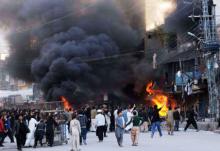
Qadeer Abbasi is recovering from a broken arm in his two-room shanty home not far from the capital, Islamabad.
On Nov. 15, Abbasi, 34, offered noontime Friday prayers at Madrassa Taleem ul Quran when the seminary was attacked by a procession of Shiite mourners. Besides the Sunni madrassa, the Shiites also struck 100 shops, four private banks, and scores of cars.
In less than an hour, 12 people were killed and intense gunfire prevented humanitarian services from ferrying the injured to hospitals.
WHEN I FOUND out years ago that most early Pentecostal denominations had been committed to nonviolence—including the Assemblies of God, the denomination of my heritage—I thought it was about the dumbest thing I’d ever heard. Not kill for the United States of America (or any country)?
Then I stumbled upon the Pentecostal Evangel, a weekly magazine of the Assemblies of God (USA), which published these revealing words during World War I:
From the very beginning the [Pentecostal] movement has been characterized by Quaker principles. The laws of the Kingdom, laid down by our elder brother, Jesus Christ, in the Sermon on the Mount, have been unqualifiedly adopted, consequently the movement has found itself opposed to the spilling of the blood of any man.
This was new to me. I was reared in a U.S. Pentecostalism that taught intense loyalty to the United States and deep pride in combatant military service. Where did this hidden history of Pentecostal nonviolence come from?
Reading other early accounts of Pentecostal peacemaking prompted me to further examine where it had gone and whether it could re-emerge. It would also challenge and deconstruct my understanding of Christianity.
Surely there is a mine for silver, and a place for gold to be refined ... They put their hand to the flinty rock, and overturn mountains by the roots. They cut out channels in the rocks, and their eyes see every precious thing ... But where shall wisdom be found? —Job 28:1, 9-12
THE DIRT ROAD twists down into a gully at La Puya, Guatemala, and up the other side, slipping between the knee-high fields of holy corn. The river doesn’t run anymore at the bottom, but the butterflies gather in remembrance of the water of times past. Hundreds of them rest and then flutter suddenly up as a woman goes by to gather fresh basil or chipilin from the little herb and vegetable garden that grows in tires and the ground all along the blocked access road leading into the proposed gold-mine site.
La Puya is the curve in the road where a thorn tree used to stand, throwing fine sharp needles down on unsuspecting passersby. Now it is a well-ordered encampment of neighbors from the twin municipalities of San Pedro Ayampúc and San José del Golfo, 10 miles northwest of Guatemala City.
These women and men are here in a startling act of markedly Christian peaceable resistance. They have been at the gates around the clock and around the calendar since March 2, 2012, when a lone woman pulled her car across the access road to the mine, blocking some incoming machinery. Then a bus bumping down the main road stopped, and the passengers piled off when they saw what was happening.
Then more people came, and dozens stayed. They settled in for a long night that became a long season of resistance. Local communities had had enough of the obfuscation, lies, and manipulation from Radius Gold, a mining company based in Vancouver, Canada.
AS I ATTENDED seminary in my native Chicago, I heard about one senseless death after another. A six-month-old baby shot multiple times with an assault weapon; a young black girl, with promise and a future, caught in the crossfire—all casualties of gang violence.
This violence is further evidence to me that our theology is needed on the streets. A theology that can impact the crisis facing the black community must be relevant to the black community. Theology can never be disengaged from the history of black people, the “isms” that have oppressed us, and the struggles that have birthed our progress. “Relevancy,” for theology, means moving beyond the academy and the church and into the streets, where it becomes our thinking faith in action.
Does our theology have anything to say to African-American gang girls? The formation of girl gangs is rooted in the numerous social ills affecting many urban African-American communities. By taking our theology to the streets, we can offer African-American gang girls an alternative hope and future. Four theological frameworks can aid in that task.
First, a practical theology—thinking faith in action—that models Jesus’ ministry to the marginalized can reach these girls with the message of God’s compassion, peace, and hope by offering a positive relational sisterhood that can replace gang life.

Understanding the process of turning an implement of death and violence into a tool for creativity and imagination is one part of the strategy. In doing so, there is hope that participants in such an event will begin to reimagine their own world and how they engage it. After all, true change first begins with imagining the possibility of such transformation.
Further, Reyes hopes to challenge U.S. citizens to consider their relationships with guns, and moreover, the impact that value has on people in other countries. Again, in the NPR story, Reyes explains, “We have to be allowed to ask questions. If you are not allowed to ask questions, you are not free."
In La Puya, Guatemala, Christian community members are nonviolently standing up against gold and silver mining companies.
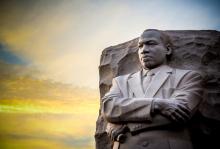
Week after bloody week, the chart of killings lengthens. And in Afghanistan, while war rages, a million children are estimated to suffer from acute malnourishment as the country faces a worsening hunger crisis.
Around this Martin Luther King, Jr. Day, we can and should remember the dream Dr. King announced before the Lincoln Memorial, the dream he did so much to accomplish, remembering his call (as the King Center asks) for nonviolent solutions to desperate concerns of discrimination and inequality within the U.S. But we shouldn't let ourselves forget the full extent of Dr. King's vision, the urgent tasks he urgently set us to fulfill on his behalf, so many of them left unfinished nearly 46 years after he was taken from us.